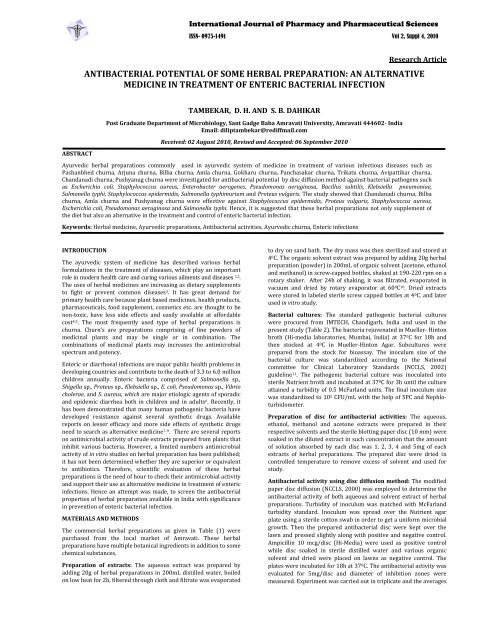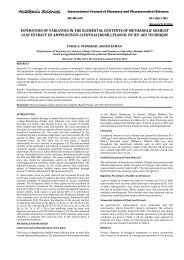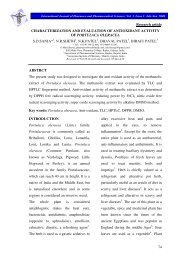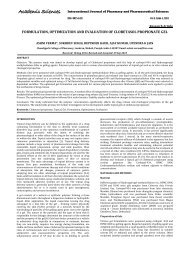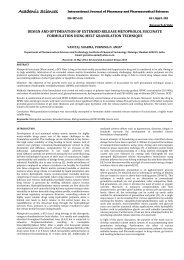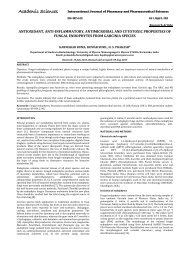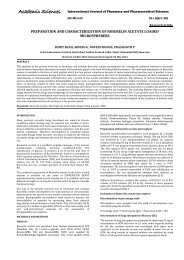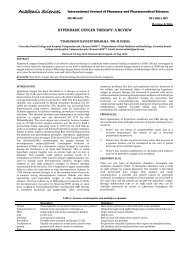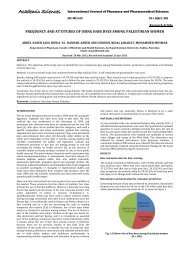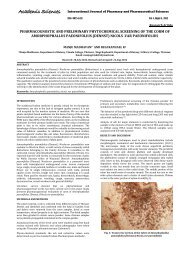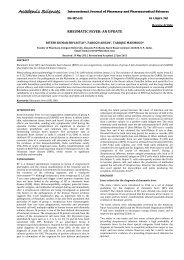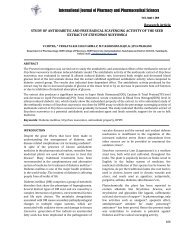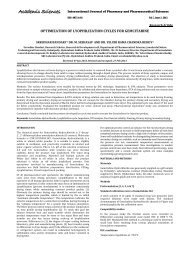antibacterial potential of some herbal preparation - International ...
antibacterial potential of some herbal preparation - International ...
antibacterial potential of some herbal preparation - International ...
You also want an ePaper? Increase the reach of your titles
YUMPU automatically turns print PDFs into web optimized ePapers that Google loves.
Research Article<br />
ANTIBACTERIAL POTENTIAL OF SOME HERBAL PREPARATION: AN ALTERNATIVE<br />
MEDICINE IN TREATMENT OF ENTERIC BACTERIAL INFECTION<br />
TAMBEKAR, D. H. AND S. B. DAHIKAR<br />
Post Graduate Department <strong>of</strong> Microbiology, Sant Gadge Baba Amravati University, Amravati 444602 India<br />
Email: diliptambekar@rediffmail.com<br />
Received: 02 August 2010, Revised and Accepted: 06 September 2010<br />
ABSTRACT<br />
Ayurvedic <strong>herbal</strong> <strong>preparation</strong>s commonly used in ayurvedic system <strong>of</strong> medicine in treatment <strong>of</strong> various infectious diseases such as<br />
Pashanbhed churna, Arjuna churna, Bilba churna, Amla churna, Gokharu churna, Panchasakar churna, Trikatu churna, Avipattikar churna,<br />
Chandanadi churna, Pushyanug churna were investigated for <strong>antibacterial</strong> <strong>potential</strong> by disc diffusion method against bacterial pathogens such<br />
as Escherichia coli, Staphylococcus aureus, Enterobacter aerogenes, Pseudomonas aeruginosa, Bacillus subtilis, Klebsiella pneumoniae,<br />
Salmonella typhi, Staphylococcus epidermidis, Salmonella typhimurium and Proteus vulgaris. The study showed that Chandanadi churna, Bilba<br />
churna, Amla churna and Pushyanug churna were effective against Staphylococcus epidermidis, Proteus vulgaris, Staphylococcus aureus,<br />
Escherichia coli, Pseudomonas aeruginosa and Salmonella typhi. Hence, it is suggested that these <strong>herbal</strong> <strong>preparation</strong>s not only supplement <strong>of</strong><br />
the diet but also an alternative in the treatment and control <strong>of</strong> enteric bacterial infection.<br />
Keywords: Herbal medicine, Ayurvedic <strong>preparation</strong>s, Antibacterial activities, Ayurvedic churna, Enteric infections<br />
INTRODUCTION<br />
The ayurvedic system <strong>of</strong> medicine has described various <strong>herbal</strong><br />
formulations in the treatment <strong>of</strong> diseases, which play an important<br />
role in modern health care and curing various ailments and diseases 1,2.<br />
The uses <strong>of</strong> <strong>herbal</strong> medicines are increasing as dietary supplements<br />
to fight or prevent common diseases3. It has great demand for<br />
primary health care because plant based medicines, health products,<br />
pharmaceuticals, food supplement, cosmetics etc. are thought to be<br />
non‐toxic, have less side effects and easily available at affordable<br />
cost4,5. The most frequently used type <strong>of</strong> <strong>herbal</strong> <strong>preparation</strong>s is<br />
churna. Churn’s are <strong>preparation</strong>s comprising <strong>of</strong> fine powders <strong>of</strong><br />
medicinal plants and may be single or in combination. The<br />
combinations <strong>of</strong> medicinal plants may increases the antimicrobial<br />
spectrum and potency.<br />
Enteric or diarrhoeal infections are major public health problems in<br />
developing countries and contribute to the death <strong>of</strong> 3.3 to 6.0 million<br />
children annually. Enteric bacteria comprised <strong>of</strong> Salmonella sp.,<br />
Shigella sp., Proteus sp., Klebsiella sp., E. coli, Pseudomonas sp., Vibrio<br />
cholerae, and S. aureus, which are major etiologic agents <strong>of</strong> sporadic<br />
and epidemic diarrhea both in children and in adults6. Recently, it<br />
has been demonstrated that many human pathogenic bacteria have<br />
developed resistance against several synthetic drugs. Available<br />
reports on lesser efficacy and more side effects <strong>of</strong> synthetic drugs<br />
need to search as alternative medicine7‐9. There are several reports<br />
on antimicrobial activity <strong>of</strong> crude extracts prepared from plants that<br />
inhibit various bacteria. However, a limited numbers antimicrobial<br />
activity <strong>of</strong> in vitro studies on <strong>herbal</strong> <strong>preparation</strong> has been published;<br />
it has not been determined whether they are superior or equivalent<br />
to antibiotics. Therefore, scientific evaluation <strong>of</strong> these <strong>herbal</strong><br />
<strong>preparation</strong>s is the need <strong>of</strong> hour to check their antimicrobial activity<br />
and support their use as alternative medicine in treatment <strong>of</strong> enteric<br />
infections. Hence an attempt was made, to screen the <strong>antibacterial</strong><br />
properties <strong>of</strong> <strong>herbal</strong> <strong>preparation</strong> available in India with significance<br />
in prevention <strong>of</strong> enteric bacterial infection.<br />
MATERIALS AND METHODS<br />
The commercial <strong>herbal</strong> <strong>preparation</strong>s as given in Table (1) were<br />
purchased from the local market <strong>of</strong> Amravati. These <strong>herbal</strong><br />
<strong>preparation</strong>s have multiple botanical ingredients in addition to <strong>some</strong><br />
chemical substances.<br />
Preparation <strong>of</strong> extracts: The aqueous extract was prepared by<br />
adding 20g <strong>of</strong> <strong>herbal</strong> <strong>preparation</strong>s in 200mL distilled water, boiled<br />
on low heat for 2h, filtered through cloth and filtrate was evaporated<br />
<strong>International</strong> Journal <strong>of</strong> Pharmacy and Pharmaceutical Sciences<br />
ISSN- 0975-1491 Vol 2, Suppl 4, 2010<br />
to dry on sand bath. The dry mass was then sterilized and stored at<br />
40C. The organic solvent extract was prepared by adding 20g <strong>herbal</strong><br />
<strong>preparation</strong> (powder) in 200mL <strong>of</strong> organic solvent (acetone, ethanol<br />
and methanol) in screw‐capped bottles, shaked at 190‐220 rpm on a<br />
rotary shaker. After 24h <strong>of</strong> shaking, it was filtrated, evaporated in<br />
vacuum and dried by rotary evaporator at 600C10. Dried extracts<br />
were stored in labeled sterile screw capped bottles at 40C. and later<br />
used in vitro study.<br />
Bacterial cultures: The standard pathogenic bacterial cultures<br />
were procured from IMTECH, Chandigarh, India and used in the<br />
present study (Table 2). The bacteria rejuvenated in Mueller‐ Hinton<br />
broth (Hi‐media laboratories, Mumbai, India) at 370C for 18h and<br />
then stocked at 40C in Mueller‐Hinton Agar. Subcultures were<br />
prepared from the stock for bioassay. The inoculum size <strong>of</strong> the<br />
bacterial culture was standardized according to the National<br />
committee for Clinical Laboratory Standards (NCCLS, 2002)<br />
guideline11. The pathogenic bacterial culture was inoculated into<br />
sterile Nutrient broth and incubated at 370C for 3h until the culture<br />
attained a turbidity <strong>of</strong> 0.5 McFarland units. The final inoculum size<br />
was standardized to 105 CFU/mL with the help <strong>of</strong> SPC and Nephlo‐<br />
turbidometer.<br />
Preparation <strong>of</strong> disc for <strong>antibacterial</strong> activities: The aqueous,<br />
ethanol, methanol and acetone extracts were prepared in their<br />
respective solvents and the sterile blotting paper disc (10 mm) were<br />
soaked in the diluted extract in such concentration that the amount<br />
<strong>of</strong> solution absorbed by each disc was 1, 2, 3, 4 and 5mg <strong>of</strong> each<br />
extracts <strong>of</strong> <strong>herbal</strong> <strong>preparation</strong>s. The prepared disc were dried in<br />
controlled temperature to remove excess <strong>of</strong> solvent and used for<br />
study.<br />
Antibacterial activity using disc diffusion method: The modified<br />
paper disc diffusion (NCCLS, 2000) was employed to determine the<br />
<strong>antibacterial</strong> activity <strong>of</strong> both aqueous and solvent extract <strong>of</strong> <strong>herbal</strong><br />
<strong>preparation</strong>s. Turbidity <strong>of</strong> inoculum was matched with McFarland<br />
turbidity standard. Inoculum was spread over the Nutrient agar<br />
plate using a sterile cotton swab in order to get a uniform microbial<br />
growth. Then the prepared <strong>antibacterial</strong> disc were kept over the<br />
lawn and pressed slightly along with positive and negative control.<br />
Ampicillin 10 mcg/disc (Hi‐Media) were used as positive control<br />
while disc soaked in sterile distilled water and various organic<br />
solvent and dried were placed on lawns as negative control. The<br />
plates were incubated for 18h at 370C. The <strong>antibacterial</strong> activity was<br />
evaluated for 5mg/disc and diameter <strong>of</strong> inhibition zones were<br />
measured. Experiment was carried out in triplicate and the averages
diameter <strong>of</strong> zone <strong>of</strong> inhibition was recorded. The <strong>antibacterial</strong><br />
activity was classified as highly active (>20mm), mild active (15‐<br />
20mm) and slightly active (12‐15mm) and less than 12mm was<br />
taken as inactive. Antimicrobial Sensitivity Index (ASI) was<br />
calculated by following formula<br />
Tambekar et al.<br />
Antimicrobial<br />
Sensitivity index for<br />
<strong>herbal</strong> <strong>preparation</strong><br />
Int J Pharm Pharm Sci, Vol 2, Suppl 4, 176179<br />
=<br />
Total zone <strong>of</strong> growth inhibition<br />
No. <strong>of</strong> antimicrobial agents tested ×<br />
no. <strong>of</strong> bacterial Pathogens<br />
Table 1: Herbal <strong>preparation</strong> tested for <strong>antibacterial</strong> <strong>potential</strong><br />
Herbal<br />
<strong>preparation</strong>s<br />
Manufacturer Therapeutic use Ingredients as per listed on package<br />
Pashanbhed Dave Ayurved Bhavan, Diuretic, diarrhoea, cough, pulmonary Bergenia ligulata<br />
churna<br />
Panvel Mumbai<br />
affections and fever<br />
Arjuna churna United Pharmacy Pune Skin disease, dysentery, syphilis, Terminalia arjuna<br />
(MS)<br />
fever, cough<br />
Bilba churna Sheetal Medi‐Care<br />
Constipation, typhoid, Intestinal Aegle marmelos<br />
Products Pvt. Ltd. Thane<br />
(MS)<br />
disorder, diarrhoea, dysentery<br />
Amla churna Ritesh Pharmaceutical Oral disease, dental carries, anemia, Emblilica <strong>of</strong>ficinale<br />
Vadodara (GJ)<br />
cold, fever, constipation, digestive<br />
disorder and liver problems<br />
Gokharu churna Ritesh Pharmaceutical<br />
Vadodara (GJ)<br />
UTI infection, female disorder Pedelium murex<br />
Panchasakar Shree Baidyanath<br />
Constipation and abdominal<br />
Rock salt, Terminalia chebula, Zingiber <strong>of</strong>ficinale,<br />
churna<br />
Ayurved Bhavan Pvt. Ltd.<br />
Nagpur<br />
distention<br />
oeniculum vulgare, Cassia angustifolia<br />
Trikatu churna Ritesh Pharmaceutical<br />
Vadodara (GJ)<br />
Digestive, tonic, stimulant. Piper longum, Piper nigrum, Zingiber <strong>of</strong>ficinale<br />
Avipattikar Shree Baidyanath<br />
Purgative, carminative,<br />
Zingiber <strong>of</strong>ficinale, Piper nigrum, Piper longum,<br />
churna<br />
Ayurved Bhavan Pvt. Ltd. hyperacidity, indigestion<br />
Terminalia chebula, Terminalia belerica, Emblica<br />
Nagpur<br />
<strong>of</strong>ficinalis, Cyperus rotundus, Elettaria cardamomum<br />
Chandanadi Shree Baidyanath<br />
Urinary infection, antiseptic,<br />
Santalum album, Acasia arabica, Syzigium cumini,<br />
churna<br />
Ayurved Bhavan Pvt. Ltd. gonorrhea,<br />
Magnifera indica, Ptychotis ajowan, Tinosporia cordifolia<br />
Nagpur<br />
cystitis, genito‐urinary affections<br />
Pushyanug Shree Baidyanath<br />
Alterative, stringent,<br />
Cyperus rotund , Cissampelos pareira, Syzygium cumini,<br />
churna<br />
Ayurved Bhavan Pvt. Ltd. diuretic, tonic, leucorrhoea and other Symplocos racemosa, Magnifera indica, Saxifera<br />
Nagpur<br />
female complication<br />
ligulataExtract <strong>of</strong> berberis aristata, Hibiscus sabdariffa etc<br />
RESULTS AND DISCUSSION<br />
In the present study, available <strong>herbal</strong> <strong>preparation</strong>s were screened<br />
for <strong>antibacterial</strong> activity against S. epidermidis, S. aureus, P.<br />
vulgaris, E. coli, K. pneumoniae, P. aeruginosa, B. subtilis, E.<br />
aerogenes, S. typhimurium and S. typhi. Among them Chandanadi<br />
churna, Bilba churna, Amla churna and Pushyanug churna were<br />
effective against Staphylococcus epidermidis, Proteus vulgaris,<br />
Staphylococcus aureus, Escherichia coli, Pseudomonas aeruginosa<br />
and Salmonella typhi.<br />
Antibacterial activity <strong>of</strong> <strong>herbal</strong> <strong>preparation</strong>s (Table. 2), It was<br />
observed that Pashanbhed churna and Arjuna churna was strong<br />
<strong>antibacterial</strong> against S. epidermidis, S. aureus and moderate against P.<br />
vulgaris and mild against E. aerogenes, P. aeruginosa, E. coli, B.<br />
subtilis, S. typhimurium. Pashanbhed churna is single plant<br />
<strong>preparation</strong> <strong>of</strong> Bergenia ligulata useful in diarrhea, cough, fever and<br />
pulmonary affections12, ingredients <strong>of</strong> Arjuna churna; Terminalia<br />
arjuna possess <strong>antibacterial</strong> properties against S. aureus, S.<br />
epidermidis, S. mutans, B. subtilis, and M. smegmatiss, K. pneumoniae<br />
and E. faecalis13. These finding indicated the presence <strong>of</strong><br />
<strong>antibacterial</strong> principle in Arjuna churna and Pashanbhed<br />
particularly strong <strong>antibacterial</strong> against S. epidermidis.<br />
Bilba churna is an important ingredient <strong>of</strong> Aegle marmelos. Its<br />
various plant parts useful in constipation, diarrhea, and fruit are<br />
used in chronic diarrhoea and dysentery and have <strong>antibacterial</strong> and<br />
antifungal properties14. Amla churna contents Emblilica <strong>of</strong>ficinalis<br />
are used to treat hemorrhage, diarrhea and dysentery15, it is<br />
<strong>antibacterial</strong> against E. coli, K. pneumoniae, K. ozaenae, P. mirabilis, P.<br />
aeruginosa, S. typhi, S. paratyphi A, S. paratyphi B, and S.<br />
marecescens16. Similar results were observed in present study, Bilba<br />
churna and Amla churna found <strong>antibacterial</strong> against S. aureus, S.<br />
epidermidis, E. coli and S. typhimurium, P. aeruginosa, S. typhi, P.<br />
vulgaris, B. subtilis, K. pneumonia and E. aerogenes. Gokharu churna,<br />
Antibacterial response<br />
16<br />
12<br />
8<br />
4<br />
0<br />
15.6<br />
Chandanadi<br />
15<br />
Amla<br />
14.2<br />
Arjuna<br />
13.2<br />
Bilba<br />
12.9<br />
Panchasakar<br />
11<br />
Gokharu<br />
9.6<br />
Pashanbhed<br />
9.3<br />
Pushyanug<br />
8.6<br />
Avipattikar<br />
Herbal product (Churna)<br />
5.9<br />
Trikatu<br />
Fig. 1: Antibacterial response <strong>of</strong> <strong>herbal</strong> <strong>preparation</strong>s<br />
Panchasakar churna and Trikatu churna was strong <strong>antibacterial</strong><br />
against S. aureus, S. epidermidis, P. vulgaris, E. coli, P. aeruginosa, K.<br />
pneumoniae and S. typhi. Ingredients <strong>of</strong> this <strong>preparation</strong> Tribulus<br />
terrestris is reported <strong>antibacterial</strong> against E. coli, S. aureus B. cereus,<br />
P. aeruginosa and antifungal against C. albicans 17. Terminalia chebula<br />
exhibited <strong>antibacterial</strong> activity against enteric bacterial pathogens<br />
such as E. coli, S. aureus, P. aeruginosa, P. vulgaris, S. epidermidis, S.<br />
typhi, S. typhimurium 18,19,13. Trikatu churna is an <strong>herbal</strong> <strong>preparation</strong><br />
177
contents three medicinal plants; Piper longum, Piper nigrum,<br />
Zingiber <strong>of</strong>ficinale (fig.1). Trikatu churna possess wide range <strong>of</strong><br />
<strong>antibacterial</strong> properties against S. epidermidis, S. aureus, P. vulgaris,<br />
B. subtilis, P. aeruginosa and K. pneumoniae. Avipattikar is<br />
<strong>preparation</strong> <strong>of</strong> Zingiber <strong>of</strong>ficinale, Piper nigrum, Piper longum,<br />
Terminalia chebula etc. It was proved potent <strong>antibacterial</strong> agent<br />
against S. epidermidis, S. aureus, P. vulgaris, K. pneumoniae, S. typhi, S.<br />
typhimurium. Chandanadi churna and Pushyanug churna was potent<br />
<strong>antibacterial</strong> against P. vulgaris, K. pneumoniae, E. coli, P. aeruginosa<br />
and S. aureus. Santalum album and Holarrhena antidysenterica are<br />
important ingredients <strong>of</strong> Chandanadi churna and Pushyanug churna<br />
and reported as <strong>antibacterial</strong> against B. subtilis, S. epidermidis P.<br />
pseudoalcaligenes, P. vulgaris and S. typhimurium 20,10.<br />
Tambekar et al.<br />
Int J Pharm Pharm Sci, Vol 2, Suppl 4, 176179<br />
From the study it was also observed that the compound <strong>herbal</strong><br />
<strong>preparation</strong> was more <strong>antibacterial</strong> while single <strong>herbal</strong> <strong>preparation</strong><br />
least <strong>antibacterial</strong> against bacterial pathogens this may be due to its<br />
synergistic or combine effects <strong>of</strong> medicinal plants. Chandanadi<br />
churna, Bilba churna, Amla churna and Pushyanug churna were<br />
strong <strong>antibacterial</strong> against Staphylococcus epidermidis, Proteus<br />
vulgaris, Staphylococcus aureus, Escherichia coli, Pseudomonas<br />
aeruginosa and Salmonella typhi which are associated with different<br />
type <strong>of</strong> infections including urinary tract infection, wound infection,<br />
otitis media, gastroenteritis, and meningitis. Study proved its<br />
traditional applications are safe as ayurvedic medicine and therefore<br />
may be useful to prevent or control the enteric infections.<br />
Table 3: Antibacterial activity <strong>of</strong> <strong>herbal</strong> <strong>preparation</strong>s against various bacterial pathogens at 5 mg/disc (Zone <strong>of</strong> inhibition <strong>of</strong> growth in<br />
mm average <strong>of</strong> 3 reading)<br />
Herbal <strong>preparation</strong>s Solvent extracts<br />
P. vulgaris<br />
(MTCC426)<br />
S. epidermidis<br />
(MTCC435)<br />
Panchasakar churna Aqueous 15 24 30 12 16 22 13 15 16 13<br />
Ethanol 16 25 28 11 15 18 18 17 13 19<br />
Methanol 18 27 32 19 20 20 17 21 15 15<br />
Acetone 16 25 32 11 16 18 22 22 14 21<br />
Pushyanug churna Aqueous 18 29 18 14 15 13 12 ‐ 13 12<br />
Ethanol 16 25 24 13 16 13 ‐ ‐ 15 12<br />
Methanol 18 27 27 12 15 15 11 ‐ 19 15<br />
Acetone 20 26 25 14 16 15 12 ‐ 16 15<br />
Pashanbhed churna Aqueous 17 28 22 16 16 12 ‐ ‐ 16 12<br />
Ethanol 17 29 19 16 16 12 ‐ ‐ 15 12<br />
Methanol 20 29 22 13 16 14 ‐ ‐ 17 14<br />
Acetone 19 31 20 17 16 16 ‐ ‐ 18 13<br />
Gokharu churna Aqueous 22 22 21 18 14 ‐ 14 15 13 13<br />
Ethanol 21 21 22 18 16 13 15 16 14 13<br />
Methanol 20 24 21 20 17 14 16 15 14 16<br />
Acetone 21 20 21 22 16 14 17 18 16 15<br />
Trikatu churna Aqueous 17 14 15 13 17 18 13 ‐ ‐ ‐<br />
Ethanol 17 19 17 12 16 17 12 ‐ ‐ ‐<br />
Methanol 16 18 17 12 16 16 13 ‐ ‐ ‐<br />
Acetone 16 18 19 14 16 17 14 ‐ ‐ ‐<br />
Amla churna Aqueous 17 20 24 20 18 17 15 16 15 18<br />
Ethanol 20 20 28 19 18 16 16 19 17 18<br />
Methanol 22 23 29 22 18 20 21 19 16 20<br />
Acetone 19 24 29 21 19 21 16 20 15 21<br />
Avipattikar churna Aqueous 17 22 20 15 ‐ 12 14 15 12 17<br />
Ethanol 15 18 18 14 ‐ 14 17 16 12 14<br />
Methanol 22 20 17 13 13 16 18 17 12 15<br />
Acetone 18 23 20 14 13 15 16 15 13 16<br />
Bilba churna Aqueous 17 22 24 19 18 15 23 19 14 19<br />
Ethanol 18 23 25 17 16 18 23 16 15 17<br />
Methanol 20 25 26 22 16 19 23 18 16 20<br />
Acetone 21 24 23 22 17 17 24 16 17 18<br />
Arjuna churna Aqueous 19 23 24 16 17 16 19 18 17 15<br />
Ethanol 21 25 23 20 19 18 20 19 17 15<br />
Methanol 21 25 26 23 21 18 21 21 20 17<br />
Acetone 20 25 27 22 19 20 22 17 16 15<br />
Chandanadi churna Aqueous 20 26 24 21 13 17 20 20 13 20<br />
Ethanol 20 28 25 20 14 20 21 21 17 18<br />
Methanol 21 28 27 22 20 23 20 21 21 19<br />
Acetone 22 30 24 21 19 19 20 20 20 22<br />
Negative control Water ‐ ‐ ‐ ‐ ‐ ‐ ‐ ‐ ‐ ‐<br />
Ethanol ‐ ‐ ‐ ‐ ‐ ‐ ‐ ‐ ‐ ‐<br />
Methanol ‐ ‐ ‐ ‐ ‐ ‐ ‐ ‐ ‐ ‐<br />
Acetone ‐ ‐ ‐ ‐ ‐ ‐ ‐ ‐ ‐ ‐<br />
Positive control Ampicillin<br />
(10mcg/disc)<br />
16 25 24 11 16 18 30 18 14 19<br />
S. aureus<br />
(MTCC96)<br />
E. coli<br />
(MTCCi739)<br />
P. aeruginosa<br />
(MTCC424)<br />
B. subtilis<br />
(MTCC441)<br />
K. pneumoniae<br />
(MTCC 109)<br />
S. typhi<br />
(MTCC i733)<br />
E. aerogenes<br />
(MTCC 111)<br />
S. typhimurium<br />
(MTCC 98)<br />
178
CONCLUSION<br />
The present study suggested that, selected ayurvedic <strong>herbal</strong><br />
<strong>preparation</strong>s have great <strong>potential</strong> as antimicrobial agent against<br />
enteric bacterial pathogens and they can be used as alternative<br />
medicine in the treatment <strong>of</strong> enteric bacterial. This study supports<br />
the use <strong>of</strong> these <strong>herbal</strong> <strong>preparation</strong>s not only as the dietary<br />
supplement but also as agent to prevent or control the enteric<br />
bacterial infections.<br />
REFERENCES<br />
1. Patwardhan B, Vaidya AD and Chorghade M, (2003).<br />
Ayurveda and natural product drug discovery. Curr Sci,<br />
86:789–799.<br />
2. Pandey MM, Rastogi S, Rawat Ajay KS, (2008). Indian <strong>herbal</strong><br />
drug for general healthcare: An overview. Int J Alter Med, 6:1‐<br />
5.<br />
3. Eisenberg DM, Davis RB and Ettner SL, (1998). Trends in<br />
alternative medicine use in the united state, 1990‐1997: Results<br />
<strong>of</strong> a fallow up national survey JAMA, 280 (18):1569‐1575.<br />
4. Ernst E, (2000). Herbal medicines: Where is evidence? BMJ,<br />
321:395‐396.<br />
5. Parle M and Bansal N, (2005). Herbal Medicine: Are they safe?<br />
Nat Prod Red, 5(1):6‐16.<br />
6. WHO, (1985). 5th Programme Report, Programme for control<br />
<strong>of</strong> diarrhoeal diseases, Geneva. WHO Bulletin, 63: 557‐772.<br />
7. Vickers A and Zollman C, (1999). ABC <strong>of</strong> complementary<br />
medicine: <strong>herbal</strong> medicine. BMJ. 319:1050 ‐1053.<br />
8. De Smet PAGM,( 2002).Herbal remedies. New Engl J<br />
9.<br />
Med.347:2046–2056.<br />
Dawson W, (2005). Herbal medicine and the EU directive, J R<br />
Coll Physicians Edinb. 35: 25‐27.<br />
10. Parekh J and Chanda S, (2007). In vitro screening <strong>of</strong><br />
<strong>antibacterial</strong> activity <strong>of</strong> aqueous and alcoholic extracts <strong>of</strong><br />
Tambekar et al.<br />
Int J Pharm Pharm Sci, Vol 2, Suppl 4, 176179<br />
various Indian plant species against selected pathogens from<br />
Enterobacteriaceae. Afr J Microbiol Research, 1(6):92‐99.<br />
11. NCCLS (National Committee for Clinical Laboratory<br />
Standards), (2002).Performance Standards for antimicrobial<br />
susceptibility testing. 8th Informational Supplement.<br />
M100S12. National Committee for Clinical Laboratory<br />
Standards. Villanova, Pa.<br />
12. Gehlot NK, Sharma VN and Vyas DS, (1976). Some<br />
pharmacological studies on ethanolic extract <strong>of</strong> Bergenia<br />
ligulata. Ind J Pharmacol, 8:92‐95.<br />
13. Rani P and Khullar N, (2004). Antimicrobial evaluation <strong>of</strong> <strong>some</strong><br />
medicinal plants for their antienteric <strong>potential</strong> against multi‐<br />
drug resistant Salmonella typhi. Phytotherapy Res, 18(8):670‐<br />
673.<br />
14. Dabur R, Gupta A, Mandal TK, Singh DD, Bajpai V, Gurav AM<br />
and Lavekar GS, (2007). Antimicrobial activity <strong>of</strong> <strong>some</strong> Indian<br />
medicinal plants. Afr J Trad CAM, 4(3):313 –318.<br />
15. Parrotta AJ, (2001). Healing plants <strong>of</strong> Peninsular India. CABI<br />
Pub, New York, 308.<br />
16. Chopra D and Simon D, (2000). The Chopra Centre Herbal<br />
Handbook. Rider publication, London.<br />
17. Elizabeth and Williamsons, (2002). Major herbs <strong>of</strong> Ayurveda,<br />
Churchill living stone, Elsevier Science Ltd, London.<br />
18. Kim HJ, Yokozawa T, Kim HY, Tohda C, Rao TP and Juneja LR,<br />
(2005). Influence <strong>of</strong> amla (Emblica <strong>of</strong>ficinalis Gaertn.) on<br />
hypocholesterolemia and lipid peroxidation in cholesterol‐fed<br />
rats. J Nutr Sci Vitaminol, 51(6):413‐418.<br />
19. Tambekar DH, Dahikar SB and Lahare MD, (2009).<br />
Antibacterial <strong>potential</strong>s <strong>of</strong> <strong>some</strong> <strong>herbal</strong> <strong>preparation</strong>s available<br />
in India. Res J Med Medicinal Sci, 3(2):224‐227.<br />
20. Ballal M, Srujan D, Bhat K, Shirwaikar A and Shivananda P,<br />
(2001). Antibacterial activity <strong>of</strong> Holarrhena antidysenterica<br />
(Kurchi) against the enteric pathogens. Ind J Pharmacol,<br />
33:392‐393.<br />
179


